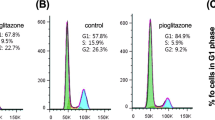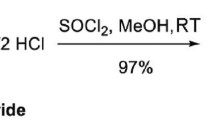Summary
The glycolytic inhibitor, 2-deoxy-D-glucose (2-DG), has been shown to inhibit the growth of certain cancers. α-Difluoromethylornithine (DFMO) is an irreversible inhibitor of ornithine decarboxylase (ODC), the ratelimiting enzyme in polyamine biosynthesis. DFMO has been shown to inhibit cancer growth in a number of models. The present study was designed to investigate the effects of 2-DG alone and combined with DFMO on MC-26 mouse colon adenocarcinoma tumors growing in vivo. Twenty-eight male Balb/c mice were inoculated with 250,000 MC-26 cells, and then randomized into four groups of 7 each: group I served as control; group II received DFMO (3% in drinking water); group III received 2-DG (500 mg/kg/d IP); group IV received a combination of 2-DG and DFMO. Treatment began 5 days after tumor cell inoculation. MC-26 tumor area was reduced 73% by DFMO compared to a 24% reduction caused by 2-DG. The tumor weight was reduced 80% by DFMO and 52% by 2-DG. The tumor contents of DNA, RNA, and protein were significantly reduced by DFMO but not 2-DG. The tumor concentration of the polyamines putrescine and spermidine were reduced by DFMO alone or combined with 2-DG while spermine levels remained unchanged. 2-DG alone did not alter polyamine levels. These results indicate that both 2-DG and DFMO, when added as single agents, inhibit tumor growth. However, the addition of 2-DG to the DFMO regimen inhibited the antitumor effects of DFMO. Survival studies performed on MC-26 cells in vitro corroborated the antagonisms between DFMO and 2-DG that were shown in vivo.
Similar content being viewed by others
References
Tabor CW, Tabor H: Polyamines. Ann Rev Biochem 53:749–790, 1984
Pegg AE, McCann PP: Polyamine metabolism and function. Am J Physiol 243:C212-C221, 1982
Slocum RD, Kaur-Sawhney R, Galston AW: The physiology and biochemistry of polyamines in plants. Arch Biochem Biophys 235:283–303, 1984
Pegg AE: Recent advances in the biochemistry of polyamines in eukaryotes. Biochem J 234:249–262, 1986
Williams-Ashman HG, Canellakis ZN: Polyamines in mammalian biology and medicine. Perspectives Biol Med 2:421–453, 1979
Janne J, Poso H, Raina A: Polyamines in rapid growth and cancer. Biochim Biophys Acta 473:241–293, 1978
Raina A, Eloranta T, Pajula R-L, Mantyjarvi R, Tuomi K: Polyamines in rapidly growing animal tissues. In: Gaugas JM (ed) Polyamines in Biomedical Research. John Wiley & Sons, New York, 1980, pp 35–49
Scalabrino G, Ferioli ME: Polyamines in mammalian tumors, Part I. Adv Cancer Res 35:152–268, 1981
Scalabrino G, Ferioli ME: Polyamines in mammalian tumors, Part II. Adv Cancer Res 36:1–102, 1982
Scalabrino G, Ferioli ME: Polyamines in mammalian ageing: an oncological problem, too? A review. Mech Ageing Develop 26:149–164, 1984
Bachrach U, Ben-Joseph M: Tumor cells, polyamines, and polyamine derivatives. In: Russell DH (ed) Polyamines in Normal and Neoplastic Growth. Raven Press, New York, 1973, pp 15–26
Russell DH: Ornithine decarboxylase as a biological and pharmacological tool. Pharmacology 20:117–129, 1980
Koch-Weser J, Schlechter PJ, Bey P, Danzin C, Fozard JR, Jung MJ, Mamont PS, Seiler N: Potential of ornithine decarboxylase inhibitors as therapeutic agents. In: Morris DR, Marton LJ (eds) Polyamines in Biology and Medicine. Marcel Dekker Inc, New York, 1981, pp 438–453
Fozard JR, Koch-Weser J: Pharmacological consequences of inhibition of polyamine biosynthesis with DL-α-difluoromethyl-ornithine. Trends Pharmacol Sci 3:107–110, 1982
Heby O, Janne J: Polyamine antimetabolites: biochemistry, specificity, and biological effects of inhibitors of polyamine synthesis. In: Morris DR, Marton LJ (eds) Polyamines in Biology and Medicine. tMarcel Dekker Inc, New York, 1981, pp 243–310
Marx M, Glass EJ, Townsend Jr CM, Barranco SC, Thompson JC: Treatment of colon cancer by α-difluoromethylornithine, an inhibitor of polyamine biosynthesis. Surg Forum 34:439–440, 1983
Saydjari R, Townsend Jr CM, Barranco SC, Thompson JC: Cyclosporine and α-difluoromethylornithine exhibited differential effects on colon and pancreatic cancer in vitro. Invest New Drugs 5:251–258, 1987
Marx M, Townsend Jr CM, Barranco SC, Glass EJ, Thompson JC: Treatment of pancreatic cancer by α-difluoromethylornithine (DFMO), an inhibitor of polyamine biosynthesis (Abstr.) Dig Dis Sci 28:941, 1983
Saydjari R, Townsend Jr CM, Barranco SC, Thompson JC: Effects of cyclosporine and α-difluoromethylornithine on the growth of mouse colon cancer in vitro. Life Sci 40:359–366, 1987
Saydjari R, Townsend Jr CM, Barranco SC, James E, Thompson JC: Effects of cyclosporin A and α-difluoromethylornithine on the growth of hamster pancreatic cancer in vitro. J Natl Cancer Inst 77:1087–1092, 1986
Sunkara PS, Prakash NJ: Inhibitors of polyamine biosynthesis as antitumor and antimetastatic agents. In: Sunkara PS (ed) Novel Approaches to Cancer Chemotherapy. Academic Press Inc., New York, 1984, pp 93–126
Sjoerdsma A, Schechter PJ: Chemotherapeutic implications of polyamine biosynthesis inhibition. Clin Pharmacol Therap 35:287–300, 1984
Tisdale MJ: The future: nutritional pharmacology. Clin Oncol 5:381–405, 1986
Jain VK, Kalia VK, Sharma R, Maharajan V, Menon M: Effects of 2-deoxy-D-glucose on glycolysis, proliferation kinetics and radiation response to human cancer cells. J Radiation Oncology Biol Phys 11:943–950, 1985
Demetrakopoulos GE, Linn B, Amos H: Starvation, deoxysugars, ouabain, and ATP metabolism in normal and malignant cells. Cancer Biochem Biophys 6:65–74, 1982
Winsett OE, Townsend Jr CM, Glass EJ, Rae-Venter B, Thompson JC: Gastrin stimulated growth of colon cancer. Surg Forum 33:384–386, 1982
Corbett TH, Griswold Jr DP, Roberts BJ, Peckham J, Schabel Jr FM: A mouse colon-tumor model for experimental therapy. Cancer Chemo Ther Rep, Part 2. 5:169–186, 1975
Dunzendorfer U, Russell DH: Altered polyamine profiles in prostatic hyperplasia and in kidney tumors. Cancer Res 38:2321–2324, 1978
Ogur M, Rosen G: The nucleic acids of plant tissues. I. The extraction and estimation of desoxypentose nucleic acid and pentose nucleic acid. Arch Biochem 25:262–276, 1950
Burton K: A study of the conditions and mechanism of the diphenylamine reaction for the colorimetric estimation of deoxyribonucleic acid. Biochemistry 62:315–323, 1956
Dische Z: Qualitative and quantitative colorimetric determination of heptoses. J Biol Chem 204:983–997, 1953
Lowry OH, Rosebrough J, Farr AL, Randall RJ: Protein measurement with the Folin phenol reagent. J Biol Chem 193:265–275, 1953
Rubin P: Clinical Oncology A Multidisciplinary Approach, 6th Edition. American Cancer Society, New York, 1983
Alarcon J, Greenwood GR: Adenocarcinoma of the colon and rectum: a review of surgical treatment in 302 patients. Dis Col Rect 22:35–39, 1979
Townsend Jr CM, Beauchamp RD, Singh P, Thompson JC: Growth factors and intestinal neoplasms. Am J Surg (In Press)
Warburg O: On the origin of cancer cells. Science 123:309–314, 1956
Demetrakopoulos GE, Brennan MF: Tumoricidal potential of nutritional manipulations. Cancer Res (Suppl) 42:756s-765s, 1982
Siddiqi M, Iype PT: Studies on the uptake of 2-deoxy-D-glucose in normal and malignant rat epithelial liver cells in culture. Int J Cancer 15:773–780, 1975
Laszlo J, Humphreys SR, Goldin A: Effects of glucose analogues (2-deoxy-D-glucose, 2-deoxy-D-galactose) on experimental tumors. J Natl Cancer Inst 24:267–281, 1960
Sokoloff B, Eddy WH, Saelhof CC, Beach J: Glucose antagonists in experimental cancer. Arch Pathol Lab Med 59:729–732, 1955
Ball HA, Wick AN, Sanders C: Influence of glucose antimetabolites on the Walker tumor. Cancer Res 17:235–239, 1957
Landau BR, Laszlo J, Stengle J, Burk D: Certain metabolic and pharmacologic effects in cancer patients given infusions of 2-deoxy-D-glucose. J Natl Cancer Inst 21:485–494, 1958
Purohit SC, Pohlit W: Experimental evaluation of the glucose antimetabolite, 2-deoxy-D-glucose (2-DG), as a possible adjuvant to radiotherapy of tumors: 1. Kinetics of growth and survival of Ehrlich ascites tumor cells (EATC) in vitro and of growth of solid tumors after 2-DG and X-irradiation. J Radiation Oncology Biol Phys 8:495–499, 1982
Gridley DS, Nutter RL, Kettering JD, Mantik DW, Slater JM: Mouse neoplasia and immunity: effects of radiation, hyperthermia, 2-deoxy-D-glucose, and Corynebacterium parvum. Oncology 42:391–398, 1985
Kalia VK, Jain VK, Otto FJ: Optimization of cancer therapy: Part IV — Effects of 2-deoxy-D-glucose on radiation induced chromosomal damage in PHA-stimulated peripheral human leukocytes. Indian J Exp Biol 20:884–888, 1982
Colofiore JR, Ara G, Berry D, Belli JA: Enhanced survival of adriamycin-treated Chinese hamster cells by 2-deoxy-D-glucose and 2,4-dinitrophenol. Cancer Res 42:3934–3940, 1982
Author information
Authors and Affiliations
Additional information
Dr. Upp was awarded a fellowship grant from the American Cancer Society Texas Division.
Rights and permissions
About this article
Cite this article
Saydjari, R., Upp, J.R., Alexander, R.W. et al. 2-deoxy-D-glucose inhibits the antitumor effects of α-difluoromethylornithine on the growth of colon cancer in vivo . Invest New Drugs 7, 131–138 (1989). https://doi.org/10.1007/BF00170849
Issue Date:
DOI: https://doi.org/10.1007/BF00170849




